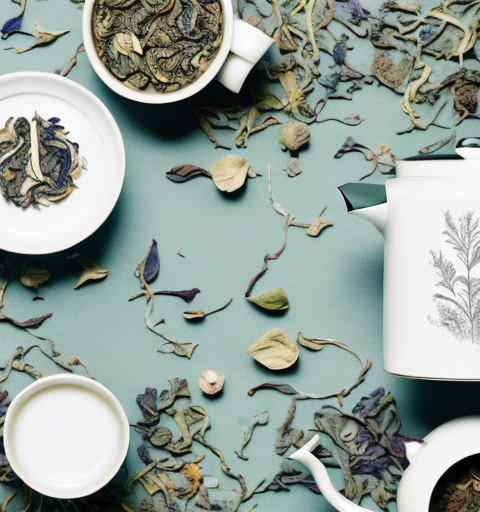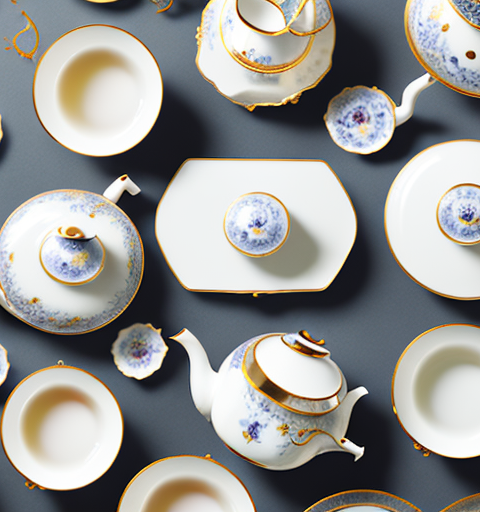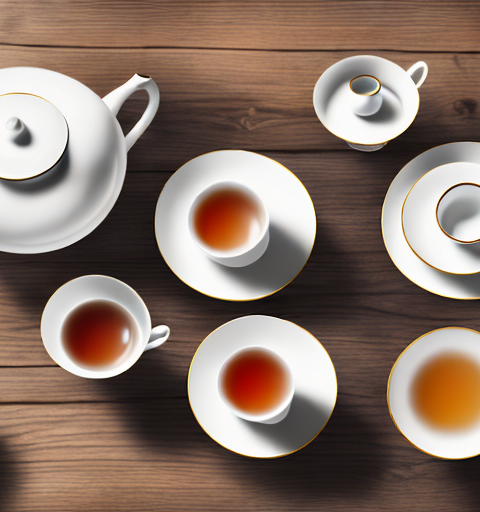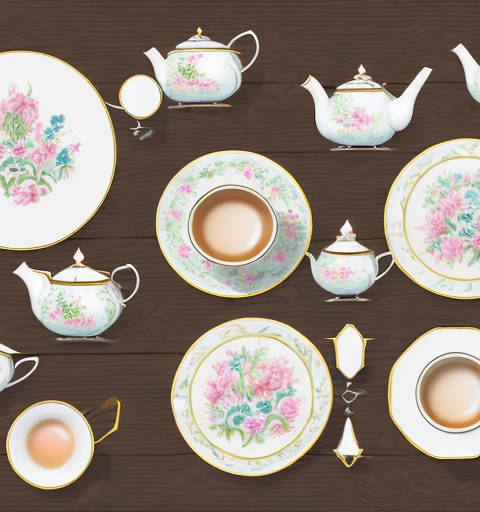The ceramic handle of a teapot is not only a functional component but also an important design element that adds to the overall aesthetic appeal of the teapot. However, over time, tea stains can accumulate on the ceramic handle, detracting from its pristine appearance. In this article, we will explore the importance of keeping your teapot clean, the impact of tea stains on the aesthetic appeal of your teapot, the challenges of removing tea stains from a ceramic teapot handle, and various methods and remedies to effectively remove these stains. We will also discuss preventative measures and alternative materials for teapot handles that are more resistant to staining.
Understanding the importance of keeping your teapot clean
Maintaining a clean teapot is not just about hygiene; it also ensures the longevity of your teapot and preserves its visual appeal. A dirty teapot, with tea stains and buildup, can be unappealing to guests and may impact the taste of your tea. Regular cleaning prevents the accumulation of stains and ensures a pleasant tea-drinking experience.
In addition to the aesthetic and taste-related reasons for keeping your teapot clean, regular cleaning also helps to prevent the growth of bacteria and mold. Over time, if left uncleaned, these microorganisms can multiply and contaminate your tea, potentially leading to health issues. By maintaining a clean teapot, you can enjoy your tea without worrying about any potential health risks. It is recommended to clean your teapot after each use, using warm water and mild dish soap, to ensure proper hygiene and the best possible tea-drinking experience.
Tea stains and their impact on the aesthetic appeal of your teapot
Tea stains on your teapot handle can significantly diminish its visual appeal. They can make your teapot look old and neglected, undermining its overall beauty. Tea stains can also seep into the porous surface of the ceramic handle, making them more challenging to remove. It is crucial to address these stains promptly to maintain the attractive appearance of your teapot.
Furthermore, tea stains can not only affect the aesthetic appeal of your teapot but also impact its functionality. When tea stains accumulate on the handle, they can create a slippery surface, making it difficult to grip and pour tea. This can lead to accidents and spills, potentially damaging your teapot or causing injury. Regular cleaning and removal of tea stains can help ensure a safe and enjoyable tea-drinking experience.
In addition to the handle, tea stains can also affect other parts of your teapot, such as the spout and lid. These stains can build up over time, resulting in a dull and discolored appearance. Not only does this detract from the overall beauty of your teapot, but it can also impact the taste of your tea. Tea stains can alter the flavor and aroma of your brew, affecting your tea-drinking experience. Proper maintenance and cleaning of your teapot can help prevent these issues and preserve the quality of your tea.
The challenges of removing tea stains from a ceramic teapot handle
Removing tea stains from a ceramic teapot handle can be a daunting task. The porous nature of the ceramic material allows stains to penetrate deep into the surface, making them resistant to regular cleaning methods. Additionally, the ergonomic design of teapot handles, with their intricate curves and crevices, can make it even more difficult to reach and clean every nook and cranny.
One method that can be effective in removing tea stains from a ceramic teapot handle is using a mixture of baking soda and water. Baking soda is a natural abrasive that can help lift and remove stains from the surface of the ceramic. To use this method, create a paste by mixing baking soda with a small amount of water until it forms a thick consistency. Apply the paste to the stained areas of the teapot handle and gently scrub with a soft brush or sponge. Rinse thoroughly with water to remove any residue.
Another option for removing tea stains from a ceramic teapot handle is using white vinegar. Vinegar is known for its cleaning properties and can help break down and dissolve stubborn stains. To use this method, soak a cloth or sponge in white vinegar and apply it to the stained areas of the teapot handle. Let it sit for a few minutes to allow the vinegar to penetrate the stains, then scrub gently with a brush or sponge. Rinse thoroughly with water to remove any vinegar residue.
Exploring the ergonomic design of ceramic teapot handles and their susceptibility to staining
Ceramic teapot handles are often designed with ergonomics in mind, ensuring a comfortable grip while pouring tea. However, this ergonomic design can also make them more susceptible to staining. The curves and indentations in the handle provide the perfect hiding spots for tea residue to accumulate and form stains. Understanding the design of your teapot handle can help you develop effective cleaning strategies.
When it comes to cleaning ceramic teapot handles, it is important to consider the material and finish of the handle. Some handles may have a glossy or smooth surface, which can make it easier to wipe away stains. However, handles with a matte or textured finish may require more thorough cleaning to remove stubborn stains.
Step-by-step guide to removing tea stains from a ceramic teapot handle
To remove tea stains from a ceramic teapot handle, follow these simple steps:
- Start by rinsing the teapot handle with warm water to remove any loose tea leaves or debris.
- Apply a small amount of dish soap or a gentle cleansing agent to a soft cloth or sponge.
- Gently scrub the stained areas of the handle in a circular motion, applying light pressure.
- Rinse the handle thoroughly with warm water to remove any soap residue.
- If the stains persist, create a paste by mixing baking soda with water. Apply the paste to the stained areas and let it sit for a few minutes before scrubbing gently.
- Rinse the handle again to remove the baking soda paste.
- Dry the teapot handle with a clean, lint-free cloth.
Following these steps consistently will help restore the pristine appearance of your ceramic teapot handle.
It is important to note that different types of tea stains may require different cleaning methods. For example, stubborn stains caused by black tea may require a stronger cleaning agent or a longer soaking time.
Additionally, regular maintenance and cleaning of your ceramic teapot handle can help prevent tea stains from becoming deeply ingrained. Wiping the handle with a damp cloth after each use and avoiding prolonged exposure to tea can help keep it looking clean and stain-free.
Effective home remedies for tackling stubborn tea stains on ceramic surfaces
In addition to using dish soap and baking soda, there are several other home remedies that can be effective in removing stubborn tea stains from ceramic teapot handles:
- Vinegar: Soak a cloth in white vinegar and wrap it around the stained areas of the handle. Let it sit for a few hours before rinsing off the vinegar and scrubbing gently.
- Lemon juice: Apply lemon juice directly to the stains and let it sit for a while. The acidic properties of lemon juice can help break down the stains.
Remember to rinse the handle thoroughly after using these remedies to prevent any lingering smells or tastes.
Another effective home remedy for tackling stubborn tea stains on ceramic surfaces is using a paste made from baking soda and hydrogen peroxide. Mix equal parts of baking soda and hydrogen peroxide to form a thick paste. Apply the paste to the stained areas of the ceramic teapot handle and let it sit for about 30 minutes. Then, scrub the stains gently with a soft brush or sponge. Rinse off the paste thoroughly with water. The combination of baking soda and hydrogen peroxide can help lift and remove tough tea stains from the ceramic surface.
Baking soda and its magical properties in eliminating tea stains on ergonomic teapot handles
Baking soda is renowned for its cleaning properties and can be highly effective in removing tea stains from ceramic teapot handles. As mentioned earlier, creating a paste of baking soda and water and applying it to the stained areas can help break down the stains and restore the handle’s appearance. The gentle abrasive nature of baking soda aids in removing the buildup without damaging the ceramic surface.
In addition to its stain-removing properties, baking soda also has deodorizing qualities. This means that not only will it remove the tea stains from the ergonomic teapot handles, but it will also help eliminate any lingering odors. This is particularly useful if the teapot handles have absorbed the aroma of different teas over time. By using baking soda, you can ensure that your teapot handles not only look clean but also smell fresh.
How to use hydrogen peroxide to restore the pristine appearance of your ceramic teapot handle
Hydrogen peroxide is another powerful cleaning agent that can be used to tackle tea stains on ceramic teapot handles. To use hydrogen peroxide, follow these steps:
- Apply a small amount of hydrogen peroxide directly to the stained areas of the handle.
- Let it sit for a few minutes to allow the peroxide to penetrate the stains.
- Gently scrub the stains using a soft cloth or sponge.
- Rinse the handle thoroughly with warm water to remove any residual peroxide.
- Dry the teapot handle with a clean, lint-free cloth.
Hydrogen peroxide is a potent cleaner, but it is essential to handle it with care and follow the instructions on the bottle.
It is important to note that hydrogen peroxide should not be used on colored or painted ceramic teapot handles, as it may cause discoloration or damage to the finish. Before using hydrogen peroxide, test it on a small, inconspicuous area of the handle to ensure it does not have any adverse effects. Additionally, always wear gloves and work in a well-ventilated area when using hydrogen peroxide to avoid skin irritation or inhalation of fumes.
Preventing future tea stains on your ceramic teapot handle through proper maintenance and care
While cleaning methods can help remove existing tea stains, preventing future stains is equally important. Here are some tips for maintaining a clean and stain-free ergonomic teapot handle:
- After each use, rinse the teapot handle with warm water to remove any tea residue promptly.
- Use a soft-bristled brush to clean hard-to-reach areas of the handle, ensuring all crevices are thoroughly cleaned.
- Regularly deep clean your teapot handle using the aforementioned cleaning methods to prevent the buildup of stubborn stains.
By incorporating these practices into your teapot maintenance routine, you can minimize the occurrence of tea stains on the ceramic handle.
Additionally, it is important to avoid using abrasive cleaning agents or harsh chemicals on the ceramic teapot handle, as these can cause damage and discoloration. Stick to gentle, non-abrasive cleaners specifically designed for ceramic surfaces.
Furthermore, when storing your teapot, make sure to keep it in a dry and well-ventilated area. Moisture can contribute to the growth of mold and mildew, which can stain the handle and affect its overall cleanliness. Consider using a teapot cozy or cover to protect the handle from dust and moisture when not in use.
Professional cleaning options for a deep cleanse of your ceramic teapot handle
If home remedies and regular cleaning methods fail to remove stubborn tea stains, you may consider professional cleaning options. Ceramic teapot handles can be delicate, so it is crucial to consult with professionals experienced in ceramic restoration and cleaning. They can use specialized techniques and products to give your teapot handle a deep cleanse and restore its pristine appearance.
One professional cleaning option for ceramic teapot handles is ultrasonic cleaning. This method involves placing the teapot handle in a tank filled with a cleaning solution and subjecting it to high-frequency sound waves. The vibrations created by the sound waves help to dislodge dirt, stains, and residue from the handle’s surface, resulting in a thorough cleanse.
Another option is steam cleaning. This technique utilizes high-temperature steam to remove dirt and stains from the ceramic teapot handle. The steam is applied directly to the handle, penetrating the pores of the ceramic and loosening any grime or discoloration. Steam cleaning is effective in removing tough stains and can also help sanitize the handle, eliminating bacteria and germs.
Exploring alternative materials for teapot handles that are more resistant to staining
If tea stains on your ceramic teapot handle continue to be a persistent issue, you may want to explore alternative materials that are more resistant to staining. Materials such as stainless steel or heat-resistant plastics can provide a durable and stain-resistant handle for your teapot.
Another alternative material to consider for teapot handles is silicone. Silicone handles are known for their heat resistance and non-stick properties, making them a great option for preventing staining. Additionally, silicone handles are often easy to clean and maintain, further reducing the risk of tea stains.
Furthermore, wooden handles can also be a viable alternative for teapots. Wood is naturally resistant to staining and can add a unique aesthetic to your teapot. However, it is important to choose a type of wood that is suitable for use with hot liquids and can withstand regular cleaning to ensure longevity.
Tips and tricks for maintaining a clean and stain-free ergonomic teapot handle
Here are some additional tips and tricks to help you maintain a clean and stain-free ergonomic teapot handle:
- Avoid leaving tea in the teapot for an extended period. Empty the teapot and rinse the handle promptly after each use.
- Regularly inspect your teapot handle for any signs of staining and address them promptly.
- Store your teapot in a clean and dry place to prevent the accumulation of dirt and moisture that can contribute to staining.
By incorporating these tips into your teapot maintenance routine, you can keep your teapot handle in excellent condition for years to come.
Understanding the role of proper brewing techniques in minimizing tea stains on your teapot handle
The brewing technique you use can also influence the likelihood of tea stains on your teapot handle. Minimizing the amount of loose tea leaves and using quality tea filters or strainers can significantly reduce the chances of stains being transferred to the handle. Additionally, brewing tea at the appropriate temperature and time can help prevent over-extraction and residue buildup.
Frequently asked questions about removing tea stains from ceramic teapot handles answered
1. Can I use bleach to remove tea stains from my ceramic teapot handle?
Bleach can be too harsh for ceramic surfaces and may cause damage or discoloration. It is best to avoid using bleach and opt for milder cleaning options.
2. How often should I deep clean my ceramic teapot handle?
The frequency of deep cleaning will depend on how frequently you use your teapot. As a general guideline, aim to deep clean your teapot handle every few months or whenever you notice significant staining.
3. Will using a dishwasher remove tea stains from my ceramic teapot handle?
While dishwashers can be effective at cleaning teapots, they may not be as effective in removing stubborn tea stains from ceramic teapot handles. Hand washing with specific cleaning methods may yield better results.
In conclusion, removing tea stains from a ceramic teapot handle requires diligence, patience, and the use of appropriate cleaning techniques. By understanding the importance of cleanliness, the impact of tea stains on the teapot’s aesthetic appeal, and the challenges associated with removing these stains, you can take the necessary steps to prevent and eliminate tea stains. Whether you opt for homemade remedies or professional cleaning services, maintaining a clean and stain-free ergonomic teapot handle will ensure your tea-drinking experience remains enjoyable and your teapot retains its beauty for years to come.






